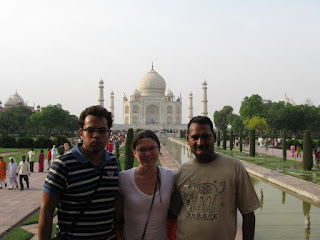Dr. Madhu, myself and Munna at the Taj Mahal
The weekend was fantastic...even though our mission was not accomplished. We were called to help rescue an elephant that was in rough shape from a hotel near Agra Saturday morning. The Wildlife S.O.S and Help In Suffering coordinated efforts to meet in Delhi headquarters in the early morning on Saturday, which meant that Dr. Madhu, Munna and I had to take the overnight bus. If you aren't into steel arm rests, I would highly recommend not taking the bus as they are fixed to the chair, thus no matter what position you are in the steel digs into your body....take the train where you can fully lie down with a pillow and blanket! Anyhow, we drove up to this hotel and to our surprise, the elephant was not there. This was highly disappointing. Before I forget, I have to introduce Munna, he is one of the greatest mahouts (elephant keepers) in India and knows almost every mahout in the country. Munna has a magical way of interacting with elephants. His voice is calm, gentle but firm and the elephants listen to him. We brought him along because of all of us, he would have the greatest chance at convincing the mahout and elephant owner to relocate the elephant to a sanctuary and provide a better life for both the mahout and elephant. Most organizations I have observed in Asia thankfully adopt the policy of sustainability for both elephant and mahout, thereby allowing the elephant to maintain the bond with its keeper, and the mahout to feed his family. Since we were so close to the Taj Mahal, we decided we would go see it. Munna has never been, so it seemed like the perfect opportunity. But before the Taj, I have to tell you about Wildlife S.O.S's Agra Bear Rescue Facility which was on the way. D

ancing Bears are Indian Sloth Bears used for street entertainment purposes by a nomadic gypsy tribe called Kalahandars. Sloth bears are caught from the wild when they are only a few months old with their mother killed to facilitate capture of the cubs. A hot iron rod is then placed though their delicate muzzle to allow for easy handling with a coarse rope. Their canines are then broken with stones or iron chisels and male bears castrated without anaesthesia. They then live their lives on a four foot rope and perform petty dances for our entertainment.

The photo to your left illustrates the equipment used and if you look closely at

the bear's muzzle in the following photo, you will noticed it is permanently severed. If you ever see dancing bears, please do not fuel the industry by watching, let the community know there are other alternatives by contacting Wildlife S.O.S. They will seize the bear, offer a substantial amount of money to the family and provide training for men and women to earn a living through other means. So far over 450 bears have been rescued. We met with the head vet of the facility who gave us a tour of the bear hospital. I was thoroughly impressed to see an ultrasound, dental x-ray, and x-ray machine as well as a fully equipped dental unit, incubator for growing cultures and a well stocked lab! If you are into bear medicine, this is definitely the place to be! The rescue centre itself was wonderful with the bears living in a natural enclosure with all sorts of enrichment that changes daily. We said our farewells to the bear rescue team and headed to see the Taj. The drive up to it was anything but exciting, the state of Uttar Pradesh, known as "UP" is one of the poorer run states thus there is little if any updated infrastructure. Anyhow, once we finally managed to weave through kilometers of dirty chaos we made it to the gates of the Taj. This is a time when I would recommend having seen "Slumdog Millionaire" in advance so you don't get scammed by street kids trying to sell you a high value tour. There are actual government guides once you get in, so don't waste your time trying to find the best one before you enter! The Taj is simply, the most beautiful building in the world. Taking only 22 years to build, with 20 000 artisans working daily, and let's not forget to mention the more than 1000 elephants bringing building materials from all over Asia! It was built by Emperor Shah Jahan in 1653 in loving memory of his third wife, with whom he had 14 children with. If you are in India it is a site you must visit.

There is a good summary of the Taj on wikipedia if you are interested to

learn more. Munna made a cute comment which was that he thinks he should make something similar for his wife!


 Over the past week and a half, Dr. Madhu and I have surveyed 81 elephants for saddle injuries. All elephants have the same work schedule and saddle composition. The elephants previously worked endlessly and carried up to 4 tourists to and from Amber Fort. Now they are only allowed a maximum of 2 people and a work day no longer than 4 hours. Dr. Madhu and Elephant Family/ Help in Suffering deserve tremendous praise for implementing these changes. When Dr. Madhu arrived in 2005, he said the saddle sores were horrendous.
Over the past week and a half, Dr. Madhu and I have surveyed 81 elephants for saddle injuries. All elephants have the same work schedule and saddle composition. The elephants previously worked endlessly and carried up to 4 tourists to and from Amber Fort. Now they are only allowed a maximum of 2 people and a work day no longer than 4 hours. Dr. Madhu and Elephant Family/ Help in Suffering deserve tremendous praise for implementing these changes. When Dr. Madhu arrived in 2005, he said the saddle sores were horrendous. It seems that the management changes have been responsible for minimizing the back lesions. The photo on the left is of an old back sore.
It seems that the management changes have been responsible for minimizing the back lesions. The photo on the left is of an old back sore. 

 the kings were riding elephants centuries ago. It is made of iron ore and weighs 50 kg, the enormous straw bed that it sits on weighs 30 kg and the proceeding thick saddle pads weigh another 20 kg. A minimum of 2 people are required to don the saddle and it takes about 20 minutes. Thus as you can imagine, removing the saddle for rest during the day is not feasible as it is so labour intensive to manipulate.
the kings were riding elephants centuries ago. It is made of iron ore and weighs 50 kg, the enormous straw bed that it sits on weighs 30 kg and the proceeding thick saddle pads weigh another 20 kg. A minimum of 2 people are required to don the saddle and it takes about 20 minutes. Thus as you can imagine, removing the saddle for rest during the day is not feasible as it is so labour intensive to manipulate.

 I have provided a photo of Dr. Madhu showing an elephant owner a photo of the saddle to the left, his expression is priceless.
I have provided a photo of Dr. Madhu showing an elephant owner a photo of the saddle to the left, his expression is priceless. 

 We started building the saddle on Monday. Our first model, Rangmala (above and to the left) was more than ready to stand pretty for measurements to get her new saddle. Each elephant is a different size and shape thus every saddle must be custom made.
We started building the saddle on Monday. Our first model, Rangmala (above and to the left) was more than ready to stand pretty for measurements to get her new saddle. Each elephant is a different size and shape thus every saddle must be custom made. 


















